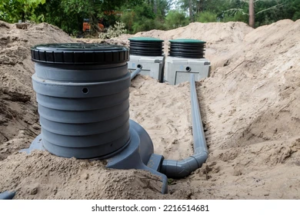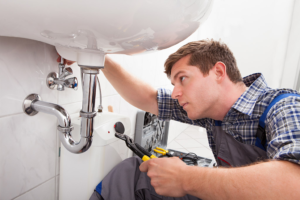Septic tanks hold wastewater from your toilets, tubs, showers, sinks, washing machines and dishwashers. Solid materials sink to the bottom and form sludge, while grease and other light items float on top of the wastewater, forming a layer called scum.
Bacteria break down these organic materials in the oxygen-free environment of the septic tank. The filtered water, known as effluent, leaves the tank through a pipe into your septic system’s drain field (also called a leach field). Click the https://www.septictankarmadale.com.au/ to learn more.

All wastewater from your toilets, showers, kitchen sinks and laundry flows into one main sewer line that slopes underground toward the septic tank. Inside the tank, heavy solids settle to the bottom and oil and grease float to the top where they partially decompose. Bacteria then breaks down the rest of the waste, forming a sludge. A septic tank provides a basic form of wastewater treatment and allows the liquid waste (effluent) to exit into the drain field.
When the septic tank is full, a pump lifts the sludge and pumps it to the surface where it is spread out over the absorption field. A distribution box evenly distributes the incoming wastewater among a series of trenches in the septic system’s drainfield, so that each part of the field gets treated equally.
The absorption field is made of a perforated tile or gravel in a trench, with an abundance of openings that allow water to seep through the soil. As the wastewater infiltrates the soil, microbes in the soil digest it, removing bacteria, viruses and excess nutrients. The resulting effluent percolates through the ground or surface water, leaving the site and recharging groundwater or entering a nearby river or stream.
Some septic systems treat wastewater more thoroughly than others. For example, some advanced septic tanks use aeration to inject oxygen into the sewage. The oxygen helps break down organic solids faster and reduces pathogen levels. Some septic tanks also incorporate anaerobic digestion, which uses a process that occurs in the absence of oxygen to help speed up decomposition and breakdown of organic solids.
The type of septic tank you have and the way your septic system is maintained determine how well it treats the wastewater in your home. To get the most out of your septic tank, have it pumped when needed and use a natural or chemical bacteria treatment regularly. Keep trees, shrubs and long-rooted grass away from the drainfield; roots can clog the system. Conserve water by limiting the number of flushes and load sizes, and by using low-water fixtures and appliances.
Installation
Before a septic tank is installed on your property, the contractor must complete the percolation test and obtain the appropriate building permits. Once those steps are completed, the contractor can design and excavate your septic system. This phase of the project can take five to seven days.
When the septic tank is fully installed, the inlet and outlet pipes are connected to your home plumbing. The septic tank is usually made of either concrete or plastic, and it is normally located on the ground surface near the home. During this phase, the contractor will install any necessary pumps or distribution boxes.
Once wastewater enters the septic tank, it is separated into three layers. The bottom layer consists of heavy solid wastes, which are broken down by bacteria to form sludge. The middle layer is a mixture of water and lighter solid wastes, such as oils and fats. These partially decompose to form a scum layer that rises to the top of the tank. The sludge and scum layers stay in the tank until they are flushed from the household plumbing or pumped out of the septic tank through a discharge pipe into the absorption field.
The drainfield is a series of trenches filled with gravel that allow the wastewater to seep into the soil below. The grass that grows on the drainfield provides a secondary level of sewage treatment by absorbing the filtered water into the soil. The soil also naturally filters the sewage before it seeps into underground aquifers.
As the sewage passes through the drainfield, bacteria continue to deactivate any disease germs that remain in the wastewater. The bacteria do this by using oxygen in the septic tank and in the surrounding soil. Gases that are generated by the bacterial process are released through a vent in the tank’s lid and a pipe in the roof of the house.
When the septic tank has completely emptied, a float mechanism inside the tank is activated and signals that it is time to start the process over again. Adding additives or throwing a dead cat into a new tank is not recommended because the anaerobic process requires the presence of bacteria to function properly.
Maintenance
A septic tank collects wastewater from toilets, showers, kitchen drains and garbage disposals. It holds the waste until solids sink to the bottom and liquids exit into a buried drain field. Because the septic tank handles such an important job, it is vitally important to have it maintained properly. Getting the system pumped regularly prevents it from overflowing and helps keep the sewage waste flowing in a healthy direction.
When a home is hooked up to the septic system, all of the drains in the house run to the tank. The tank is a buried, water-tight container constructed of concrete, fiberglass or high-quality polyethylene that can hold up to 1,500 gallons. The septic tank has several compartments for different types of waste and a T-shaped outlet that allows the liquid to travel through to the drain field.
The septic tank contains bacteria and other microorganisms that work to break down and digest the sewage. As the liquid moves through the septic tank, it creates a scum layer on top and a sludge layer on the bottom. The sludge and scum must be removed as part of routine maintenance.
Solids should never be flushed down the drain because they can cause the septic tank to overflow. In addition, this practice can affect how well the bacteria inside the tank works, as it can disrupt the delicate balance of sludge and scum that forms in the tank.
It is also important to avoid putting non-biodegradable materials down the drains such as cotton buds, tampons, condoms or cigarette butts. These items can clog the drains and septic tank, making it impossible for them to break down and leave the septic system.
Adding mulch around the septic tank, pipes and drain field can help prevent the soil from becoming too compacted. This allows the bacteria to continue breaking down sewage and treating it before it flows into the groundwater supply.
One of the most common problems with septic tanks is a clog in the venting system. This clog can allow disease-causing sewage gasses to escape the septic tank and enter the home. Symptoms of this problem include a strong, unpleasant odor in the home and yard.
Replacement
When sewage backs up into the house or terrible odors are present in the yard, it is a sure sign that something is wrong with the septic system. Often the tank is to blame, but a failing drainfield can also cause septic problems. When this occurs, a new septic system must be installed. However, the cost can be prohibitive. Fortunately, many homeowners can save money by repairing or replacing the leach field alone.
A septic system uses natural and mechanical processes to separate solid waste from wastewater. The process involves holding the sewage in a tank for a time, so that it can undergo a settling period. This allows sediment and solid waste to sink to the bottom of the tank while scum rises to the surface. The bacteria in the septic tank break down the sludge and scum, so that they can be washed away into the drain field with the wastewater.
The tank must be pumped regularly to keep it from becoming full. The frequency of this depends on the size of the septic tank, how many people live in the home, and what goes down the drains. Items like garbage disposals and excessive water use can require a higher pumping frequency.
In some cases, a septic system may need to be replaced because of a drainfield failure. A drainfield is a large area in which the wastewater trickles through sand, organic matter (such as peat and sawdust), constructed wetlands, or other media to remove disease-causing pathogens and contaminants before it is returned to the soil.
A common reason for a drainfield to fail is that the septic tank has not been pumped regularly. When a septic tank is full, it stops protecting the drainfield from the solid waste that would otherwise clog and contaminate the groundwater supply.
If you think your septic tank is in need of replacement, you must hire an expert septic professional to examine the site and make a recommendation. The cost of a new septic system can be high, but it is an investment that will protect the health and safety of your family and your property.
